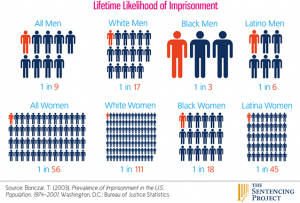Executive summary
Social justice is a core component of the social work profession. It would be unethical to ignore the injustice occurring in communities with high concentrations of minorities. The mass incarceration in the United States has become what some may consider a modern parallel to the Jim Crow laws post-Civil War, wreaking havoc on minorities and their children to come.
Introduction
For a country that boasts equality and opportunity for all, it seems that in the U.S., an unequal amount of minorities find themselves with less and less  opportunity. Even though research has shown that drug use and crime is not partial to one race or races in particular, rates of incarceration do not reflect these findings. The U.S., total population about five percent of the world population, currently possesses roughly two million prisoners, about one fourth of the world’s total prisoner population, and roughly sixty percent consists of people of color. This type of mass incarceration reaps consequences on minorities far beyond jail time – it affects minorities’ abilities to prosper economically, creates even more unsafe environments once prisoners are released due to poor prison conditions, and perpetuates a system of systematic oppression, in which stockholders in the private prison industry can benefit from high recidivism rates at privatized prisons.
opportunity. Even though research has shown that drug use and crime is not partial to one race or races in particular, rates of incarceration do not reflect these findings. The U.S., total population about five percent of the world population, currently possesses roughly two million prisoners, about one fourth of the world’s total prisoner population, and roughly sixty percent consists of people of color. This type of mass incarceration reaps consequences on minorities far beyond jail time – it affects minorities’ abilities to prosper economically, creates even more unsafe environments once prisoners are released due to poor prison conditions, and perpetuates a system of systematic oppression, in which stockholders in the private prison industry can benefit from high recidivism rates at privatized prisons.
A disproportionate prison population reflects a failed judicial system. The primary reason to oppose this injustice is moral – the majority culture remains unaffected by what goes on in a minority population. People of color find themselves limited by the effects of jail time. Mass incarceration, specifically concentrated on minorities, hurts the children of a community, whose parents cannot parent them. Mass incarceration concentrated in specific communities also hurts the community’s economy, since so many of its workers are behind bars and the conditions in prisons do not serve to rehabilitate and prepare an individual to return to their community. But perhaps the starkest parallel to the Jim Crow laws post-Civil War is a convicted individual’s lack of voting rights while incarcerated or on parole, rendering them no voice in their communities.
Results
The “criminalization” of urban spaces and the War on Drugs has led to a disproportionate amount of minorities in prison. The 1968 Supreme Court decision Terry vs. Ohio has given law enforcement much more flexibility and power to stop whoever they may deem “suspicious,” extending to even schools, arresting minors for what, up until recently, was dealt with by school administration. And having gone to prison makes it much more difficult to succeed afterwards. Employers and landlords can legally discriminate based on conviction of a felony, wrecking a convicted felon’s chances of supporting themselves and their families.
Implications and Recommendations
A society in which an industry does well based off of high prison rates is a society that is doomed to catastrophe at one point or another. Steps in the right direction would include repealing laws that specifically target urban populations (such as sleeping in public spaces), giving incarcerated individuals voting rights, eliminating mandatory sentencing on a wide scale, and most importantly, ending the private prison industry, from which stockholders gain a profit from high recidivism rates.